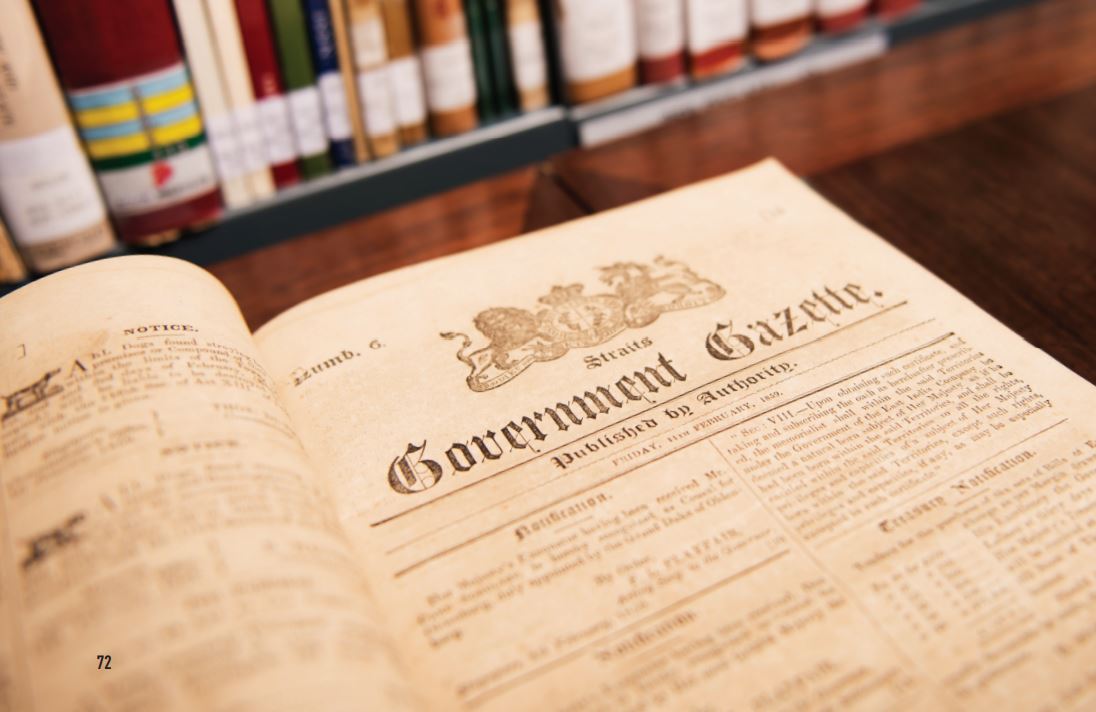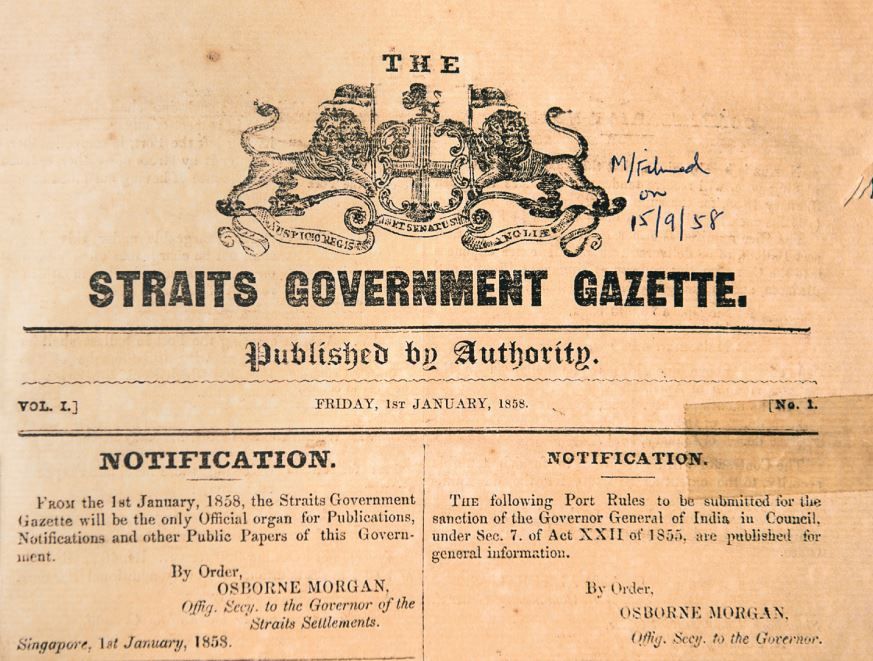Hear Ye Hear Ye
Title: Straits Government Gazette
Creator: Straits Government
Year published: 1858–67
Publisher: Mission Press (Singapore)
Language: English
Type: Serial
Call no.: RRARE 959.51 SGG
Accession nos.: B02969338G (1858-9);
B02969339H (1859); B02969340K (1860);
B02969341A (1860); B02969342B (1965);
B02969343C (1867)
In Singapore, notifications of all new laws passed by parliament are officially announced in the government gazette, a time-honoured practice that continues to this day.1 One of its earliest iterations was the Straits Government Gazette, published in 1858 when Singapore was still a part of the Straits Settlements and under the government of the Colonial Office of Calcutta in India. Similar in content to the gazette published today, the gazette at the time contained proclamations by the governors, announcements of new government appointments as well as notices of new ordinances.2
The front page of the first issue, dated 1 January 1858, consists of the title of the gazette in Gothic script, the crest of the Straits Settlements and a note asserting that the gazette “will be the only Official organ for Publications, Notifications and other Public Papers of this Government”.3 The first issue was printed on paper embossed with the watermark of the British East India Company (EIC), while subsequent issues used stocks of noticeably lower quality paper.4
So thorough was the gazette that seemingly unimportant details of the size, length and price of the paper are found on the last page, where it states that the issue contained “6–8 pages of Foolscap size. Per mensem 50 cent. Copy 25”.
The gazette was divided into sections and comprised notifications, notices and other news. Notifications typically included official announcements of new port rules, information about appointments or leave taken within the civil service, as well as bills and ordinances passed by the Legislative Council in India.
Notices consisted of announcements from the post office, calls for tender and regular reminders from the commissioner of police. From the 1860s onwards, the gazette began including other information such as timetables for mail services to India, China and Australia; notices of marriages, divorces, insolvency, burials; and collections for relief funds. Gradually, weather tables, shipping news and import tariffs were also published in the gazette, reflecting the importance of the Straits Settlements as key trading posts in the network established by the British.
The gazette employed the same layout and maintained its minimal, graphic-free aesthetic throughout its life. The only adornment was the header crest of the Straits Settlements, which went through several revisions over the years. The gazette was printed by Mission Press, the sole printing press in Singapore at the time.
The Straits Government Gazette can trace its origins to some 30 years earlier in October 18285 when it began as the weekly Government Gazette of Prince of Wales Island, Singapore and Malacca.6 It contained announcements by the government, occasionally accompanied by Jawi translations, as well as news from India and Europe, currency updates and, quite oddly, selections from works of English literature.7
This government gazette was published until July 1830, when the status of the Straits Settlements was reduced from a presidency to a residency.8 Its last issue ended with a cryptic message in Vol. 3 No.89 on 3 July 1829 in crisp Queen’s English: “We beg to announce to Subscribers the termination of this Journal. Accident rather than choice led us to assume a character which previous experience had little qualified us to discharge with ability.”9 No further attempts to establish another government publication were pursued until 1858, when the government started the Straits Government Gazette.10
The Straits Government Gazette was issued from 1858 until 1867,11 when the Straits Settlements officially achieved Crown Colony status and was governed directly by the Colonial Office in London instead of the Indian government in Calcutta. Thereafter, the gazette underwent several title changes that were indicative of Singapore’s fluctuating political circumstances.12
From 1867 to 1942, the publication was renamed the Straits Settlements Government Gazette, and after ceasing production during the Japanese Occupation (1942–45), it resurfaced as the British Military Administration, Malaya Gazette, Singapore Division, in November 1945.
The following year, on 1 April 1946, the Straits Settlements was dissolved and Singapore became a separate Crown Colony helmed by its own governor. The government published its laws in the newly minted Colony of Singapore Government Gazette.13 When Singapore attained internal self-government in 1959, the publication became known as the State of Singapore Gazette until 1965, when Singapore gained full independence and the gazette was finally retitled as the Republic of Singapore Government Gazette.14 An electronic version of the gazette, the eGazette, was made available in 1999.
– Written by Genine Loo
NOTES
-
Parliament of Singapore. (2011). Parliamentary glossary – G. Retrieved from Parliament of Singapore website. ↩
-
National University of Singapore. (2015, July 14). Singapore primary sources: Executive government (1867–1965). Retrieved from NUS Library website. ↩
-
Straits Settlements. (1858, January 1). Straits Government Gazette, 1. Microfilm no.: NL 994 (1858–59) ↩
-
Byrd, C. K. (1970). Early printing in the Straits Settlements 1806–1858 (p. 50). Singapore: Singapore National Library. Call no.: RCLOS 686.2095957 BYR ↩
-
Buckley, C. B. (1984). An anecdotal history of old times in Singapore 1819–1867 (p. 153). Singapore: Oxford University Press. Call no.: RSING 959.57 BUC-[HIS] ↩
-
Bridgman, E. C. (1837). The Chinese Repository, 5, 146. Vaduz: Kraus Reprint Ltd. ↩
-
Jarman, J. L. (Ed). (1998). Annual reports of the Straits Settlements 1855–1941 (Vol. 1, p. v). Slough: Archive Editions Limited. Call no.: RSING 959.51 STR-[AR] ↩
-
Black, E. A, & Bell, F. (Eds.). (2011). Law and legal institutions of Asia: Traditions, adaptations and innovations (p. 347). Cambridge: Cambridge University Press. Call no.: RSING 349.5 LAW ↩
-
Black & Bell, 2011, p. 347. ↩



